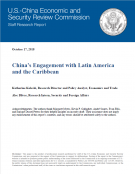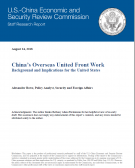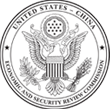Research
Research

The Internet of Things (IoT)—the interconnection of physical and virtual things via information and communication technologies—is being applied to virtually every sector from smart thermostats in households to swarms of autonomous drones in the battlefield. This report, contracted by the USCC and authored by SOS International, outlines China’s state-led approach to IoT development, assesses the implications for the U.S. economy, national security, and the privacy of U.S. data, and makes recommendations for U.S. policymakers. China’s concerted, state-led approach, including ongoing efforts to influence international IoT standards, has put China in a position to credibly compete against the United States and other leaders in the emerging IoT industry. China’s research into IoT security vulnerabilities and its growing civil-military cooperation raise concerns about gaining unauthorized access to IoT devices and sensitive data. In addition, China’s authorized access to the IoT data of U.S. consumers will only grow as Chinese IoT companies leverage their advantages in production and cost to gain market share in the United States based on the terms of use and sweeping Chinese government data access powers.
Research

The United States maintains close cultural, economic, and security ties with countries in Latin America and the Caribbean (LAC). While the United States remains the largest economic and security partner in LAC, in the last decade China has rapidly deepened its economic, diplomatic, and military engagement to become the region’s largest creditor and second-largest trading partner. China’s efforts in the region are driven by four key objectives: (1) ensuring its access to the region’s abundant natural resources and consumer markets; (2) gaining LAC support for its foreign policies; (3) shaping LAC perceptions and discourse about China; and (4) gaining geopolitical influence in a region geographically close and historically subject to U.S. influence. Closer ties with China may reduce U.S. influence in the region; they can also reinforce the region’s overreliance on highly cyclical exports and create unsustainable debt burdens for some LAC countries, which China could use for political leverage. This report examines China’s objectives in the region, its economic, diplomatic, and military and security engagement in Latin America and the Caribbean, and the implications of its expanding regional presence and influence for the United States.
Research

China uses “United Front” work to co-opt and neutralize sources of potential opposition to the policies and authority of its ruling Chinese Communist Party (CCP). The CCP’s United Front Work Department (UFWD)—the agency responsible for coordinating these kinds of influence operations—mostly focuses on the management of potential opposition groups inside China, but it also has an important foreign influence mission. To carry out its influence activities abroad, the UFWD directs “overseas Chinese work,” which seeks to co-opt ethnic Chinese individuals and communities living outside China, while a number of other key affiliated organizations guided by China’s broader United Front strategy conduct influence operations targeting foreign actors and states. Some of these entities have clear connections to the CCP’s United Front strategy, while others’ linkage is less explicit. Today, United Front-related organizations are playing an increasingly important role in China’s broader foreign policy under Chinese President and General Secretary of the CCP Xi Jinping. It is precisely the nature of United Front work to seek influence through connections that are difficult to publically prove and to gain influence that is interwoven with sensitive issues such as ethnic, political, and national identity, making those who seek to identify the negative effects of such influence vulnerable to accusations of prejudice. Because of the complexities of this issue, it is crucial for the U.S. government to better understand Beijing’s United Front strategy, its goals, and the actors responsible for achieving them if it is to formulate an effective and comprehensive response.
